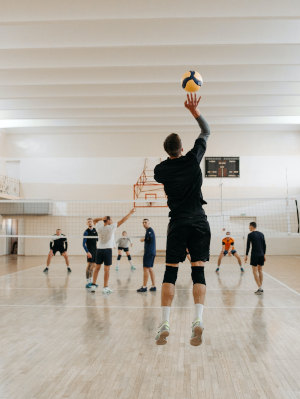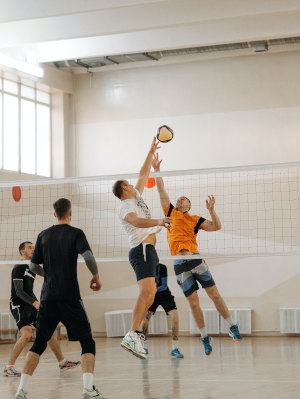William G. Morgan created the game of volleyball in 1895 in Holyoke, Massachusetts. Morgan was a physical education director at the YMCA and a student at Springfield College. The game was originally known as “mintonette.” However, the name of the game changed to volleyball after Alfred Halstead observed the game at the first exhibition match in 1896. He noticed the game’s volleying nature and named it volleyball. The first official rulebooks for the sport were published in the early 1900s, with the establishment of the Fédération Internationale de Volleyball (FIVB) in 1947.

How do you play volleyball?
Volleyball is played by two teams, consisting of six players each. The teams are separated by a net, and the objective is to score points by hitting the ball onto the other team’s court. To start playing, a team is chosen by flipping a coin. One player serves the ball by throwing it over the net and into the opposing team’s court. The receiving team must prevent the ball from touching the ground within their court. Players usually use their hands or arms to play the ball, but they are allowed to strike or push the ball with any part of their body. The team can touch the ball up to three times to return it to the other side, but the same player can’t touch the ball twice in a row. The goal is to land the ball in the opponent’s half of the court without them returning it successfully. A point is earned when the ball touches the ground inside the court or when a mistake is made. If the ball hits the other team’s side, they get a point. If a mistake is made, the team that didn’t make the error gets a point. If the ball touches the line, it’s considered to be on the court. The team that earns a point serves as the next point. If they served before, the same player serves again. If not, the players switch positions on the court in a clockwise direction. To win a set, a team must be the first to score 25 points with a two-point lead. Matches are played in a best-of-five-sets format. If necessary, a fifth set is played to 15 points, still requiring a two-point lead. There is no specific time limit for a volleyball game since it is measured in sets. Games can last up to 90 minutes.

There are several common faults in volleyball, such as:
Letting the ball touch the ground outside the opponents’ court
Catching and throwing the ball, making two consecutive contacts with the ball
Making four consecutive contacts as a team
Touching the net during play
Crossing over the boundary line or under the net with the foot.
Skills
Serve
A player stands behind a line and hits the ball, trying to make it land in the opponent’s court. The goal is to make it difficult for the receiver to return the ball. If the ball lands directly in the court or goes out after being touched by an opponent, it is called an “ace.” This happens when only the server touches the ball on their team. There are multiple types of serves, including an underhand serve, topspin, jump serve, and many more.
Pass
Passing is when a team tries to handle the opponent’s serve or attack. They must prevent the ball from touching the court and get it to the setter quickly and accurately. There are two ways to pass: underarm or overhand.
Set
Setting is when a player puts the ball in the air so their team can hit it over the net. The setter decides which player will hit the ball. They also coordinate their team’s movements. There are different types of sets, for example, overhand and bump sets. The setter usually stands on the left side of the net and faces that way. Sometimes, a setter can choose to play the ball directly onto the opponent’s court instead of setting it for a teammate. This is called a “dump.”.
Attack
In volleyball, the attack is when a player hits the ball over the net to the other team’s side. The goal is to make it hard for the other team to return the ball. There are different ways to attack the ball, for instance, the backcourt attack (this attack is performed by a player in the back row who jumps from behind the 3-meter line), the dip/dink/tip/cheat/dump (this attack involves lightly touching the ball to land in an unprotected area), and many more.
Block
Three players can perform a block to stop or change an opponent’s attack. An offensive block aims to completely stop the attack and keep the ball in the opponent’s court. A well-executed offensive block requires jumping and reaching over the net with arms and hands. A defensive block aims to control and slow down the ball. Blocking can involve one, two, or three players. A successful block doesn’t always touch the ball, as it can force the attacker into a less powerful shot.
Dig
Digging is the act of preventing the ball from touching the ground after a spike or attack. It is similar to passing but more reflex-based. Players must stay on their toes and be ready to move in any direction. Techniques like diving are commonly used to save the ball. Rolling techniques are also employed to avoid injuries.

Benefits of playing volleyball
Playing volleyball burns calories and fat, making it great for weight loss or maintenance. Harvard Medical School says a half-hour non-competitive game can burn 90–133 calories, while a competitive gym game burns 120–178. Volleyball also tones and shapes the body, strengthens muscles, and improves cardiovascular and respiratory systems. It can also increase your metabolic rate and energy levels. Playing volleyball also improves hand-eye coordination, as players must follow and strike the ball accurately. Furthermore, it builds agility, coordination, speed, and balance, as players must perform various skills that require flexibility, strength, and speed. Volleyball is heart-healthy, increasing blood circulation and overall health. It also builds muscular strength, particularly in the chest, core, legs, and arms. In addition, volleyball also enhances interpersonal skills by promoting teamwork and quick movement. A study conducted in June 2008 found that individuals who regularly participate in team sports develop better networking skills. Moreover, volleyball can boost mood, reduce stress, and increase the drive to succeed. It improves self-confidence, self-esteem, body image, and overall happiness. Being a team player in volleyball teaches valuable lessons in leadership, cooperation, and motivation.
Sources:
https://olympics.com/en/sports/volleyball/
https://en.wikipedia.org/wiki/Volleyball
https://www.healthfitnessrevolution.com/top-10-health-benefits-volleyball/
